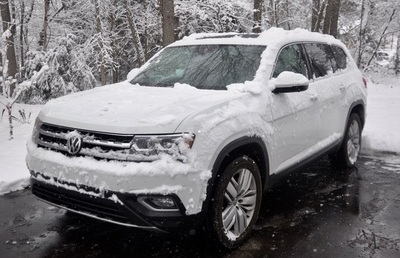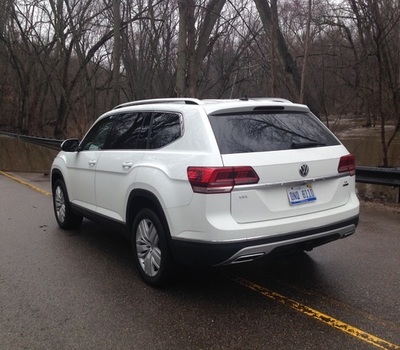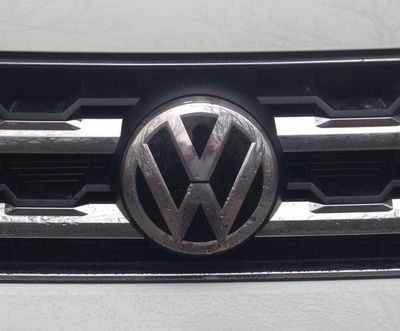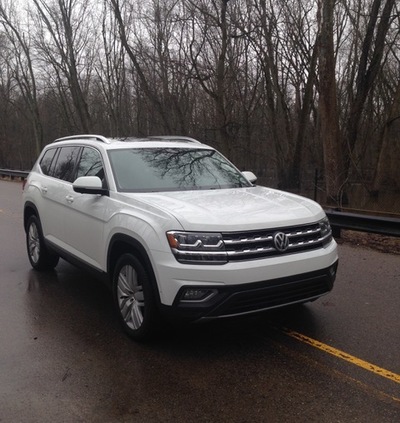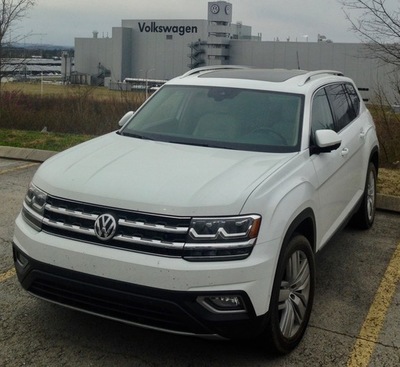Enjoy The Drive: 2018 Volkswagen Atlas Review and Road-trip By Steve Purdy
2018 VOLKSWAGEN ATLAS IN FLORIDA AND CHATTANOOGA
Review and Road Trip Story from A Shunpiker’s Journal
By Steve Purdy
The Auto Channel
Michigan Bureau
While we love the winter wonderland that is our native Michigan it sometimes becomes desirable to escape the blasts of cold and snow and head far south where the sun always shines and the balmy temps have us in short sleeves, short pants and sometimes short of breath having fun outside. For the drive our friends at Volkswagen loaned us a new mid-size Atlas three-row crossover, assembled in their sparkling new plant in Chattanooga. More on that later. So, off we went, just ahead of another snow storm heading south on I-75.
Atlas is VW’s first foray into the popular 7-passenger CUV market dominated by the GM competitors (Buick Enclave and Chevy Traverse), Nissan Pathfinder, Ford Explorer and many, many others. Most are categorized as mid-size but often feel more full-size. Just about every manufacturer, both luxury and mainstream, competes in this space. From our substantial time behind the wheel on the road this trip, I’d say VW has hit the mark squarely.
And, what is the mark? Well, it’s a cost-competitive, high-content, utilitarian vehicle that is attractive and can haul people and cargo according to a level the U.S. market expects. Past crossovers and SUVs from VW have had more of a European personality finding market acceptance in the U.S. a bit limited. Now, with the full redesign of the smaller Tiguan and recent introduction of this Atlas, that focus is much more on American tastes and expectations.
Packing the Atlas for the trip made us think we should have invited a bunch of friends to go along. Our luggage and necessary road trip incidentals for this 10-day, 3,000-mile excursion didn’t begin to challenge the truck’s cargo capacity. It has an impressive 20.6 cubic-feet of space behind the third seat and 55.5 cubic-feet with the third-row seatbacks folded. We can fold the second row to make a cavernous 96.8 cubic-feet for our stuff. These numbers represent nearly best-in-class. The second-row seats fold and lean forward for easy access to the fairly generous third row. The Atlas’ nicely squared-off profile makes for efficient use of space.
Sunday morning traffic was as light as ever we’ve seen. Approaching Cleveland midday we finally had to kick off our adaptive cruise control and dice through traffic in manual mode. That boxy, but aesthetically appealing (especially for VW fans) exterior design certainly does not enhance its coefficient of drag. The VW engineers have managed the aerodynamics reasonably well in spite of its brick-like profile. A massive, ribbed hood implies a truck-like personality. We sensed a hint of trickiness, but mostly it was just a large, comfortable space.
There is no question of Atlas’ brand identity viewed from the front, not only because of its exaggeratedly horizontal corporate design language, but also the bold VW badge in the center of the crisp grille - nothing flashy, trendy or swoopy to confuse the eye, just the typically German simplicity and functional style. Unobtrusive sculpting around the wheel wells and along the side flow into a rear view with simple, rectangular taillights and horizontal chrome trim bar. Dual exhaust outlets and large, 20-inch alloy wheels add a little panache, as do lots of LED lights, including DRLs.
We pulled into a cheap hotel north of Atlanta for the night after an easy eleven hours. We had become very comfortable very quickly in the cabin. I could have driven for hours more. The generous leather front seats have an excellent range of adjustment and we found controls and readouts mostly intuitive and easily managed. The horizontal orientation of the interior made it feel even bigger than I anticipated. The Teutonic design continues inside with good materials, upscale trim and good sound insulation. Some of the functions managed on the multi-purpose screen were less than intuitive, at least for this tech-challenged guy. As a long-standing fan of the VW brand I felt like we were in the competent, solid, unpretentious vehicle I expected.
Our tester is the top-of-the-line SEL Premium with 4Motion full-time all-wheel drive. The sticker shows a bottom line of just under 50-grand including destination charge but no options. It comes with just about everything you can imagine except navigation, like: panoramic sunroof, leather seating, lots of driver assistance technology, remote start, 360-degree camera system, power lift gate, integrated trailer hitch, large multi-function screen, and lots of other premium content. You can get into the entry-level Atlas, by the way, for just a tad over 30-grand.
I found the driving dynamics throughout our first leg of about 750 miles quite satisfactory. Throttle response, steering feedback, suspension tuning . . . all felt good. Acceleration was less than impressive but entirely adequate. We found a couple of instances where the throttle-triggered downshifts were a bit harsh, but plenty quick and smooth in manual mode. I’m not fond of start/stop systems generally but this one is less intrusive than most. Overall, I’d give the tactile quality of the Atlas above average marks.
Managing the audio functions caused a little problem as I tried to change satellite stations but it was just a learning curve issue as I had not noticed one of the icons that allows it more easily. HVAC is one of the simplest and best we’ve experienced lately with three large knobs at the base of the center stack just above a handy, deep bin wherein resides USB and auxiliary ports and a 12-volt outlet. The thoughtful designers have included a small shelf on top of the dash where we can put our phone or other small objects so they don’t slide away.
Under the hood is a transverse 3.6-liter V6 making 276 horsepower and 266 pound-feet of torque mated to an 8-speed automatic transmission. The EPA says we can expect about 23 mpg on the highway, 17 in the city and 19 mpg combined on regular fuel. And, they’re mighty close, according to our experience. We averaged just over 22 mpg for the whole trip and, of course, most was highway. You can also get a 2.0-liter turbo with mostly similar numbers except you get lots more torque and a flatter torque curve. That mean it will feel considerably more powerful. Towing capacity is rated at up to 5,000 pounds.
VW’s new car warranty covers the whole Atlas for 6 years or 72,000 miles. That’s one of the best warranties in the business.
A few days visiting friends and relatives in southwest Florida served as one impetus for the trip, so we did some beach drumming, garden visits, lazing by the pool, a nature hike and other Florida stuff. We drove over to a Wednesday morning ‘cars-and-coffee’ at a shopping center off busy Highway 41 near Northport in my brother’s ’32 Ford classic hot rod pickup, rumbling down the highway with the rumble of a classic flat-head V8 and proudly wearing her primer and patina like an old dancing girl in her underwear. These regular static shows draw an amazing variety of cars. My favorite was a mild custom, or maybe a retro-rod (hard to delineate categories) ’57 Ford 2-door station wagon.
Now, back to Chattanooga:
The other impetus for this trip was a visit to VW’s much-lauded assembly plant in Tennessee. Sorry to report, though, we were unable to tour the Chattanooga plant as we intended. Our visit coincided with the changeover to the new Jetta and an expansion to accommodate more production for Atlas. Instead, our tour guide, Keith, gave us a tour of the VW Academy, which turned out to be much more than a training center for employees. It turned out to be an interesting story in itself.
Tucked into a small valley well back from I-75 just north of Chattanooga sits the assembly plant from which this Atlas comes. The rolling 1,400-acre parcel is shared with a couple suppliers but dominated by the VW plant with 1.9-million square-feet under roof and an expansion going on now. When this southeast Tennessee plant opened in 2011 it made just the Jetta mid-size sedan. Then, last year, production began for the Atlas.
In spite of all the industrial activity in the valley it appears they’ve gone to great lengths to mitigate their impact on the environment. It still is quite an attractive complex and they are proud to tell us they are the only auto manufacturing plant in the world to get Leadership in Energy and Environmental Design (LEED) platinum certification, a mighty prestigious international environmental credential, it seems from some limited research.
VW’s first attempt at U.S. production did not go so well. From 1978 to 1988 lots of Golfs, including one of my GTIs, came out of a troubled factory in Pennsylvania. That plant went belly up for a variety of reasons not the least of which were chronic labor disputes and wide cultural differences between German owners and U.S. managers and workers. VW closed that plant without replacing it. Finally, they decided to follow the lead of most other Asian and German competitors and return to building cars here, particularly ones that are designed more for the U.S. market. And, that’s how this plant began.
Before we go further, let’s address the controversy that played out during the plant’s first few years. Suffering ever more dismal membership numbers, the United Auto Workers union tried to organize the new VW plant. Tennessee is a “right to work” state. The VW execs did not object as would most manufacturers, in fact, they even offered a German-style works counsel as an alternative. About that time Senator Bob Corker interjected some ugly politics into the fray by saying if VW allowed a union, a works council or anything similar he would see to it that they never got any more public support. Well, the issue died off, only the maintenance staff are organized now and the company remains open to whatever the workers want to do for representataion, we’re told. The factory also pays well and treats its workers and the community well, or so it looks from this outside.
The VW Academy houses all the training and educational projects for the plant and some for surrounding school districts. They not only train all the shop workers, as every factory must, but they also provide college level students hands-on, practical training in a three-year program of work and study. Students get paid while earning an associates degree that will qualify them for high-end jobs, at VW or any other employer.
They also have what is often called “alternative education” programs for students who don’t fit into the traditional academic setting but have other potentials. The Academy provides the entire education experience for those students, including basic academics. The State of Tennessee partners on some of these educational programs.
The future of the Chattanooga plant looks bright. Automotive News reported a few months ago VW will likely build a series of battery electric vehicles that the company already announced will be sold in the U.S. beginning 2020.
VW offers public tours of the plant. If you’ve not been in a modern auto plant you’re in for a surprise.
© Steve Purdy, Shunpiker Productions, All Rights Reserved
The Most Helpful Volkswagen Research Information; Anywhere!
- Volkswagen Buyers Guide | Specs, Prices, Expert Reviews and Comparisons 2018-1997
- Find Your Perfect New Car Match
- 20+ Years of The Auto Channel Volkswagen Reviews
- Volkswagen Brand Archives; News, Reviews, Specifications, Prices, Video, Images (79,986 Annotations)



